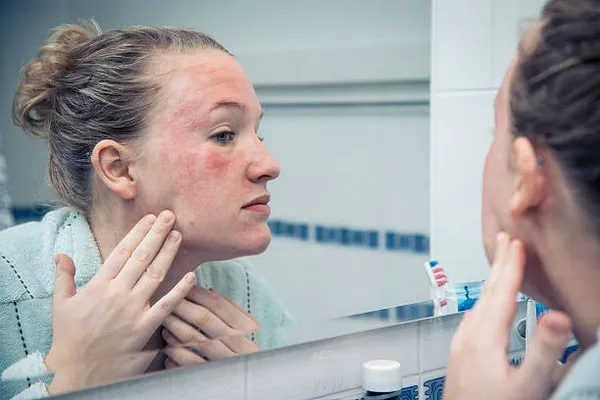Allergic Contact Dermatitis (ACD) is a common skin condition that arises when the skin comes into contact with a substance triggering an allergic reaction. The manifestation of this dermatitis includes a spectrum of lesions, each offering visual cues to the trained eye. In this comprehensive article, we delve into the intricate world of ACD, dissecting the appearance of lesions caused by this condition and shedding light on the diverse ways the skin responds to allergens.
Understanding Allergic Contact Dermatitis: A Brief Overview
Before delving into the visual aspects, it’s essential to grasp the fundamentals of Allergic Contact Dermatitis. ACD is a type of eczematous skin reaction resulting from an immune response to substances encountered in daily life. These substances, known as allergens, can range from metals and plants to cosmetics and fragrances.
The Visual Language of Lesions: A Closer Look
ACD lesions can vary widely in appearance, and their characteristics are influenced by several factors, including the allergen involved, the duration of exposure, and individual skin sensitivity. Let’s explore the diverse forms these lesions can take:
1. Erythema (Redness):
One of the earliest signs of ACD is redness or erythema at the site of contact.
The red hue is a result of increased blood flow to the affected area due to inflammation.
2. Edema (Swelling):
Swelling often accompanies erythema, creating a raised and inflamed appearance.
Edema is a response to the immune system releasing chemicals to combat the allergen.
3. Papules:
Small, raised bumps known as papules can develop, resembling insect bites.
Papules are a result of the immune response causing localized inflammation.
4. Vesicles:
ACD may lead to the formation of vesicles, fluid-filled blisters resembling tiny bubbles.
These vesicles result from the accumulation of fluid beneath the skin’s surface.
5. Weeping and Crusting:
In severe cases, vesicles may rupture, causing weeping and the formation of crusts.
Weeping is the oozing of fluid, and crusts form as the fluid dries.
6. Scaling and Peeling:
As the dermatitis progresses, affected areas may exhibit scaling and peeling of the skin.
This is a result of the skin’s attempt to repair itself and shed damaged layers.
7. Erosions and Ulcers:
Prolonged inflammation can lead to erosions and ulcers, where the skin surface breaks down.
Erosions are shallow, while ulcers involve deeper skin layers.
8. Post-inflammatory Hyperpigmentation:
Following resolution, some individuals may experience darkening of the skin known as hyperpigmentation.
This occurs due to the deposition of pigment during the healing process.
Common Allergens and Their Lesions: A Comparative Analysis
Different allergens can induce distinct lesion patterns. Let’s explore the relationship between common allergens and the lesions they typically cause:
1. Nickel:
Lesions: Papules, vesicles, and erythema.
Affected Areas: Often seen in jewelry-wearing areas like the ears and wrists.
2. Poison Ivy, Oak, or Sumac:
Lesions: Linear streaks, vesicles, and intense itching.
Affected Areas: Contact with the plants, commonly on exposed skin.
3. Fragrances and Cosmetics:
Lesions: Erythema, papules, and itching.
Affected Areas: Face, neck, and other areas with cosmetic application.
4. Latex:
Lesions: Erythema, edema, and vesicles.
Affected Areas: Commonly on hands or areas in direct contact with latex.
Chronic ACD: Long-term Impact on Skin Appearance
In cases of chronic or recurrent ACD, the skin’s appearance may undergo changes over time. Prolonged exposure to allergens can lead to thickening of the skin (lichenification) and alterations in pigmentation. These chronic changes emphasize the importance of early identification and allergen avoidance.
Diagnostic Tools: Confirming ACD Through Patch Testing
While the visual examination of lesions provides crucial insights, confirming ACD often requires specialized testing. Patch testing, conducted by dermatologists, involves applying small amounts of common allergens to the skin and observing the reaction. This helps pinpoint specific triggers, enabling individuals to make informed lifestyle changes.
Management and Prevention: A Holistic Approach
Effectively managing ACD involves a multi-faceted approach:
1. Topical Steroids:
Mild to moderate cases often respond well to topical steroids, reducing inflammation.
2. Emollients and Moisturizers:
Keeping the skin well-moisturized can alleviate dryness and promote healing.
3. Avoidance of Allergens:
Identifying and avoiding contact with allergens is crucial for preventing recurrences.
4. Educational Initiatives:
Raising awareness about potential allergens and promoting preventive measures.
5. Immunomodulators:
In severe cases, immunomodulators may be prescribed to modulate the immune response.
Conclusion:
Understanding the visual language of ACD lesions is instrumental in recognizing the condition early, facilitating prompt intervention and preventing long-term consequences. By unraveling the appearance of lesions caused by ACD, individuals gain the knowledge needed to navigate their skin health effectively. In this dermatological exploration, we’ve ventured into the intricate terrain of skin reactions, empowering readers to decode the visual cues their skin provides and fostering a proactive approach to skin wellness.


